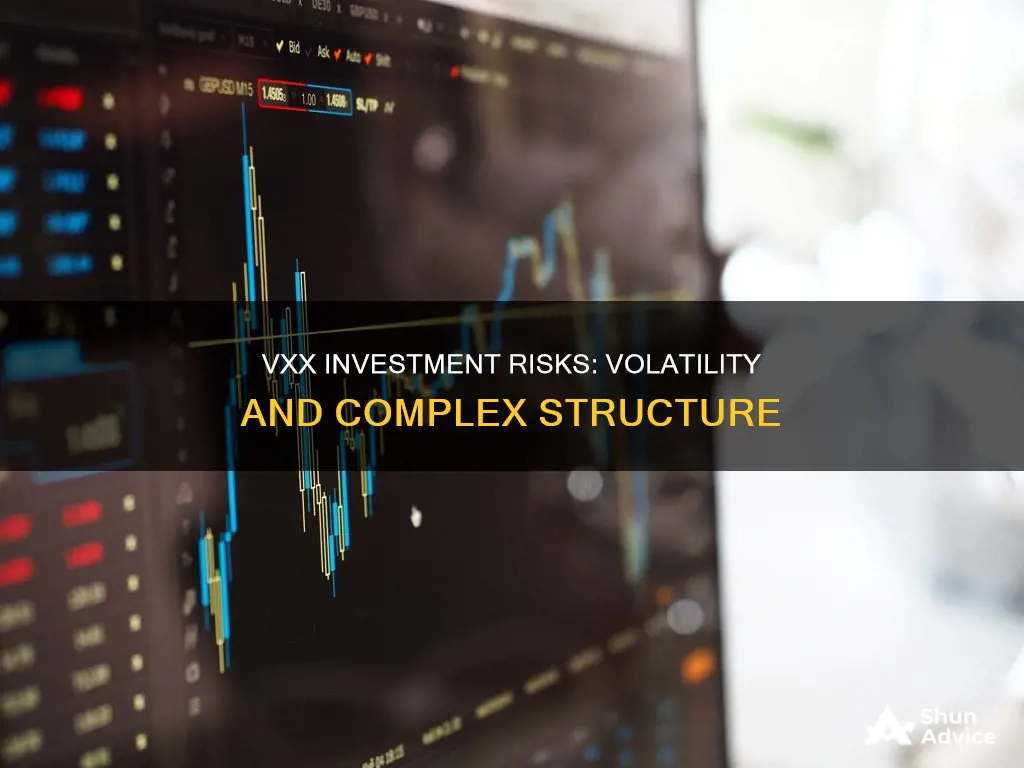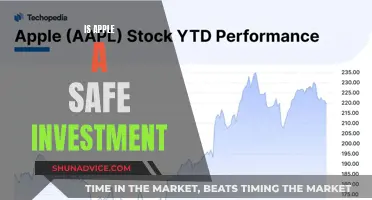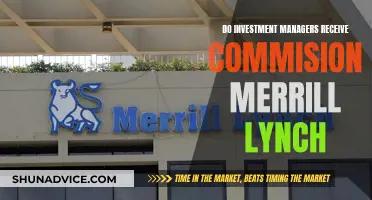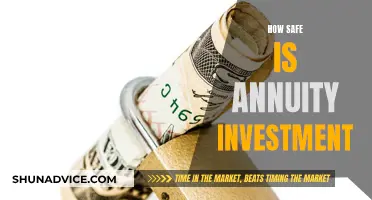
The iPath Series B S&P 500 VIX Short-Term Futures ETN (VXX) is an exchange-traded note (ETN) that enables investors to bet on the size of swings in the S&P 500 Index. It is designed to provide investors with exposure to equity market volatility. However, VXX is not without its risks.
Firstly, VXX is subject to market volatility and the risks of its underlying securities. The price of VXX can fluctuate substantially and can be influenced by unpredictable factors such as prevailing market prices, economic events, and changes to interest rate policies.
Secondly, VXX is an ETN, not an ETF, and thus does not represent ownership in a basket of securities. Instead, it is an unsecured debt instrument subject to the issuer's credit risk. VXX also experiences negative roll yield or backwardation, meaning long-term holders will incur a penalty on returns.
Lastly, VXX is only intended for short-term trading and is not suitable for long-term investment. Due to its complex structure and the nature of the volatility it tracks, VXX is a risky investment even for sophisticated investors.
| Characteristics | Values |
|---|---|
| Ticker Symbol | VXX |
| Issuer | Barclays PLC |
| Issuer Redemption Option | Yes |
| Maturity Date | 23 January 2048 |
| Management Fee | 0.89% |
| Assets Under Management | $227 million |
| Trading Mechanism | Trades like an exchange-traded fund (ETF) or a stock |
| Risk | Highly Risky |
What You'll Learn

VXX is an exchange-traded note (ETN)
ETNs are similar to ETFs (exchange-traded funds) in that they may be a popular pathway to diversification because they expose investors to a wide range of financial assets, and come with lower expense ratios compared to mutual funds. However, ETNs are distinct from ETFs. While ETFs are equity securities and may issue returns as periodic dividends, ETNs are debt instruments and issue returns as a single payout.
ETNs are long-term investments, with maturity periods anywhere from 10 to 30 years. They pay a lump sum when they mature, and investors make money if the underlying tracked asset has risen in value. ETNs are unsecured debt instruments that trade on a stock exchange. They are pegged to an underlying asset, so the value is whatever the investor loaned to the bank, plus the change in the value of the underlying asset.
ETNs are often discussed alongside ETFs, but they have crucial differences. ETFs are a basket of securities such as stocks, bonds, or commodities, while ETNs are debt instruments backed by the credit of the issuer. ETFs are similar to mutual funds, while ETNs are not overseen by a board of directors.
ETNs have some attractive tax consequences. ETN investors typically pay taxes on their investment only when they sell it for a gain or when the ETN matures. They don't distribute dividend or interest income, so most taxes are deferred and taxed as capital gains.
There are several risks associated with ETNs, including credit risk, liquidity risk, and issuance risk. Credit risk refers to the possibility that the issuing institution might fail to make good on its redemption promises. Liquidity risk refers to the wide bid-ask spreads that can occur with low trading activity. Issuance risk, also known as volatile premiums, refers to the fact that ETNs are created only by their issuers, who are effectively issuing new debt each time they create additional units.
Venture Capitalists' Investment Strategies: Key Factors for Decision-Making
You may want to see also

VXX is not a good long-term investment
VXX is a Short-Term Trading Tool
VXX is designed for short-term speculation or hedging. The VXX prospectus warns, "If you hold your ETNs as a long-term investment, it is likely you will lose all or a substantial portion of your investment." This is because VXX is based on short-term VIX futures, which have to be continuously added, and each one is usually pricier than the last, resulting in an ongoing cost and a negative return. This phenomenon is called "contango". On top of contango losses, the VXX also charges fees, as do other ETNs and ETFs.
Volatility is Hard to Predict
Investing in the VXX can make you money over a short time frame if there's a market-moving event, but it requires you to be right about the near-term direction of the market, which is challenging to do consistently. VXX often trades higher than it should during periods of low volatility and lower during periods of high volatility.
Structural Tendency to Lose Value
VXX is based on short-term guesses about an index (the VIX) that is itself based on short-term guesses. As such, it has a structural tendency to lose value over time.
Better Alternatives Exist
Many investors have made great fortunes without ever going near the VXX, instead investing in solid investments like shares of healthy, growing companies that are poised to appreciate over time, or bonds that are understood and that don't have a structural tendency to lose value over time.
A Beginner's Guide to Investing in India's Top ETFs
You may want to see also

VXX is designed to track the value of futures contracts on the Cboe Volatility Index
The Cboe Volatility Index (VIX) is a gauge of current volatility that is priced into S&P 500 index options. The VXX is designed to track the value of futures contracts on the Cboe Volatility Index.
VXX is an exchange-traded note (ETN) that tracks the S&P 500 VIX Short-Term Futures Total Return Index. This means that VXX does not track the VIX itself (spot VIX), but the futures on VIX, which often trade at very different price levels depending on the time to maturity.
VXX continuously rolls VIX futures contracts at each expiration, which can detract from performance. Since VXX must roll its futures contracts to rebalance the fund to the later contract, the fund manager is forced to sell the futures contracts that are closest to their expiration dates and buy the next dated contracts, which is a process called rolling.
Because longer-dated futures contracts are often at higher levels than shorter-dated ones (during normal market conditions), the rolling activity can result in losses (as the ETN is forced to sell the lower-valued contracts and buy the higher-priced contracts). This is known as a negative roll yield, or backwardation.
VXX experiences a negative roll yield, meaning long-term holders will see a penalty to returns. As a result, the performance of VXX is stronger in the short term but not in the long term.
VXX is influenced by many unpredictable factors, and its price can fluctuate substantially between now and its maturity date. Influential factors include prevailing market prices of the U.S. stock market, S&P 500 Index options prices, supply and demand for VXX, as well as economic, political, regulatory or judicial events, or changes to interest rate policies.
VXX is designed to enable investors to bet on the size of swings in the S&P 500 Index. It is used by individual investors and hedge fund managers alike. However, VXX is not a buy-and-hold investment strategy. It is designed for knowledgeable investors with a short-term investment goal or who may want to hedge their equity exposure.
RBI's Portfolio Investment Scheme: A Guide
You may want to see also

VXX shares will increase in value when market volatility increases
The VXX is an exchange-traded note (ETN) that is designed to provide investors with exposure to equity market volatility. It is important to note that the VXX does not track the spot VIX but the futures on VIX, which can trade at very different price levels depending on the time to maturity. The VXX must continuously roll its VIX futures contracts at each expiration, which can detract from its performance. This process, known as rolling, involves selling the futures contracts closest to their expiration dates and buying the next-dated contracts. In normal market conditions, longer-dated futures contracts are usually priced higher than shorter-dated ones, so this rolling activity can result in losses for the VXX.
However, during periods of high market volatility, short-term VIX futures contracts can sometimes trade at higher levels compared to longer-term contracts, a situation known as backwardation. In these cases, the rolling process can actually boost the performance of the VXX.
Overall, the performance of the VXX is strongly influenced by market volatility. When volatility increases, the value of VIX futures contracts increases, which leads to an increase in the value of VXX shares. On the other hand, during quiet periods for the market, VXX shares will likely trend lower.
Crafting a Personal Investment Plan: Strategies for Success
You may want to see also

VXX is only composed of derivative contracts
VXX is an exchange-traded note (ETN) that is designed to provide investors with exposure to equity market volatility. It is composed of derivative contracts, specifically futures contracts on the Cboe Volatility Index (VIX). VIX futures are contracts that allow investors to speculate on the future level of the VIX, which is often referred to as the "fear index" as it tends to rise during periods of market uncertainty and spike in times of panic.
VXX continuously rolls VIX futures contracts at each expiration, which can detract from performance. This process, known as "rolling", involves selling the futures contracts that are closest to their expiration dates and buying the next dated contracts. Since longer-dated futures contracts are often at higher levels than shorter-dated ones (during normal market conditions), this rolling activity can result in losses for the fund. This is known as a negative roll yield or backwardation.
Because of this negative roll yield, the performance of VXX is stronger in the short term but not in the long term. Over longer periods, VXX experiences significant value decay due to the negative roll yield and the fact that VIX futures tend to drift lower relative to the VIX itself. This drag on performance is known as "roll loss" or "contango loss".
Due to the nature of its underlying investments, VXX is subject to many unpredictable factors and can fluctuate substantially. Investors considering VXX should understand the risks associated with investing in derivative contracts and the volatility of the VIX. VXX is generally considered a short-term trading vehicle and may not be suitable for long-term investment horizons.
Investment Portfolio at 60: A Balanced and Secure Strategy
You may want to see also
Frequently asked questions
VXX is the ticker symbol of the iPath Series B S&P 500 VIX Short-Term Futures ETF. It is an exchange-traded note (ETN) designed to provide investors with exposure to equity market volatility.
VXX is only composed of derivative contracts, so it is subject to extreme market price movements and can be extremely volatile. It is intended for sophisticated investors who actively manage their investments daily. It is not suitable for intermediate or long-term investment time horizons.
VXX had lost 99.96% of its value since its inception in 2009 due to the high costs of its trading in VIX futures contracts. As of September 16, 2024, its three-month return was -3.42% and its three-year return was -51.76%.







